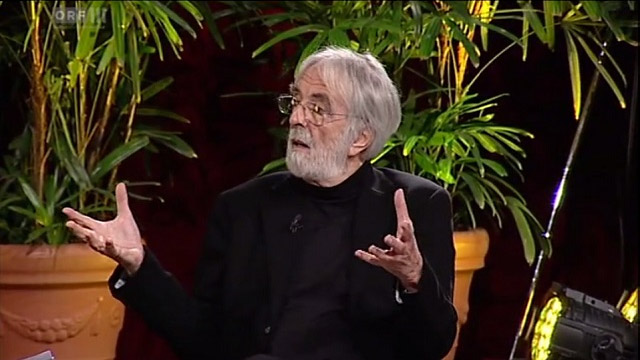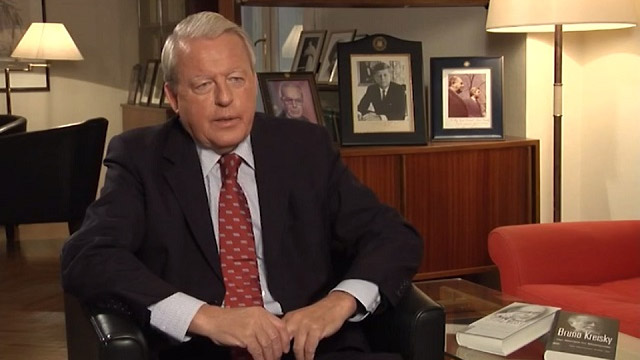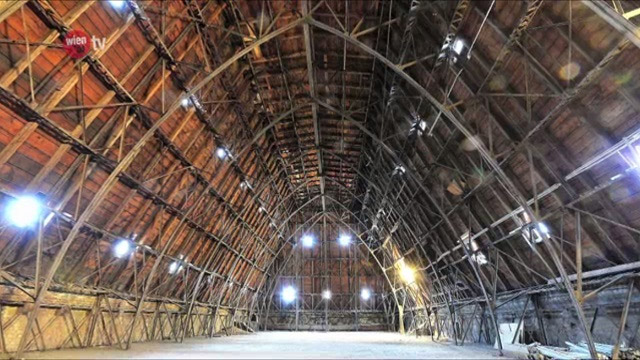Mitschrift
Vienna, home to 1,740,000 people. The population increases day by day, and could reach 2 million within the next 20 years. The Austrian capital is among the fastest-growing cities in Europe, and continues to enjoy exceptional water quality.Vienna's spring water originates in distant mountains, and the city uses 390 million litres of water - every day.
The city's water comes primarily from the Rax, Schneeberg and Hochschwab mountains in the Limestone Alps of Lower Austria and Styria.The Hochschwab Mountain feeds Vienna's Second Spring Water Main. The mountain is over 2000 metres high and the protected area that surrounds the springs is larger than Vienna's surface area, at 435 km2.
The provision of spring water for Austria's capital dates back to imperial times. Vienna's First Spring Water Main was established in 1873, the Second Spring Water Main was opened in 1910.
These days, it would be almost impossible to purchase the springs or land in the surrounding tree-covered catchment areas. Even if it were possible, it would be prohibitively expensive.
Perhaps this is why Vienna's water supply is so well protected, a monumental task that is the responsibility of many different people and organisations.
Spring has arrived at the Hochschwab mountain, and the snow is slowly disappearing into the ravines and cracks of the karst massif. It may take decades for today's snow to emerge from the springs in the valley below - or it may take just a few days.
The mountains provide a significant amount of the spring water, but the surrounding forests also act as a catchment area.
The forest floor retains the water and also acts as a filter.
Austria's mixed forests are ideally suited to the task. What grows and what doesn't, however, is not left to chance. Some trees must give way to provide sufficient light and space for others to grow.
Gerda Frank "That's enough light."
Gerda Frank "How are you getting on? You've got a lot done. This is a beech tree, this is a fir. We'll remove this, here."
The combination of spruce, fir and beech trees provides the perfect mixture for the springs' catchment area.
Gerda Frank, MA 49 Wildalpen Forestry Department:
"The mixture is so important because the different tree varieties have different root structures and reach different levels of the soil. The ground is therefore better able to filter out sediment, and absorb and retain the water. The different root structures are also important as protection from strong winds. The storms Kyrill, Emma and Paula of the last few years have once again shown that trees with deeper root systems are far more resistant to wind than trees with shallow roots, such as spruces. If a storm were to uproot all the spruces in a mixed forest, at least the fir and beech trees would remain standing. This prevents defoliation and is therefore also important to maintain soil conditions."
Forest management requires care and attention. The trunks are removed from the slopes using winches, cables and cranes.
Every machine requires fuel, but nothing may be allowed to soak into the ground, particularly in the protected forests around the springs.
Gerda Frank:
"Forestry experts, seasonal workers and contractors must use organic chain saw oil, a biodegradable oil made from rapeseed. There are also oil binding agents located throughout the area. If a truck or a crane experiences technical problems any oil leak can be immediately absorbed and the affected piece of ground can be removed."
When spring arrives, the higher regions of the protected area around the springs face their own challenges.
In June, the mountain huts re-open for hikers.
Christoph Rigler, MA 31 Wildalpen Manager:
"The mountain huts play a significant role within the catchment areas, as they are locations where many people congregate and create corresponding amounts of waste."
These days, the wastewater is run through small water purification plants, to ensure Vienna's water remains clean.
The waterfall consists of the same spring water that flows to Vienna, yet it flows directly into the River Salza.
70 metres inside the mountain, water is extracted from the Kläfferquelle source, the largest of the five main Hochschwab springs. - The fresh water is then evaluated on its way to Vienna.
Modern technology is used to establish the clarity and other facets of the water. The information from the various control points is collated at the Wildalpen monitoring post.
Aufsichtsposten:
This is Access Point 23. The cloudiness is currently 0,51. I can call up the line here and establish whether it is above or below a safe level. This level here shows that the water is fine.
If the spring water is clear it begins the long journey to Vienna. Otherwise, it is diverted into the River Salza.
The water flows downhill at walking pace, about 5 kilometres per hour. The difference in height from the beginning of the duct to its final destination is 360 metres.
From the Schneeberg mountain, the source of Vienna's First Spring Water Main, the journey to the city is shorter than that of the Second Spring Water Main from the Hochschwab mountain, which enters the city from the west.
From the first duct, on the right, the water arrives in Vienna within 24 hours. Water in the second duct, which flows through the west, takes 36 hours.
The First Spring Water Main ends here, at the Rosenhügel water reservoir. The second main ends nearby in the district of Mauer. From here, the water is distributed throughout Vienna.
The water is dispersed to the capital's households through 29 different reservoirs, located at various levels throughout the city. A new cistern was constructed for the Wienerberg water tower in 2011. It was embedded within the walls of the old reservoir.
The water pressure is used to create environmentally friendly electricity. The power stations of Wiener Wasser or "Vienna Water" produce enough energy to supply a town with a population of approximately 50,000 people.
The Wienerberg reservoir distributes water to the 100,000 inhabitants of Vienna's inner city districts. The water temperature is between 6 and 8 degrees Celsius.
Elisabeth Rauch: MA 31 Technical Infrastructure, Wiener Wasser
The Wienerberg reservoir is fed with water from both the first and second spring water mains. It can hold up to 47.000 cubic metres of water, and supplies the 4th, 5th and 6th districts. Depending on whether the water comes from the first or second main, it arrives here at between 4.5 and 5 bars of pressure.
The water pressure enables the water to be delivered almost without the use of pumps, but it is not sufficient to reach the heights of Vienna's changing skyline. Skyscrapers are equipped with their own water pumps.
Pumps are also required to supply the higher residential areas in the west of Vienna.
Two reservoirs on the Kahlenberg mountain are also supplied by pumps. The smallest is the Dreimarkstein reservoir, which was completed in 2012.
It supplies water to approximately 500 households and also holds water reserves for putting out fires on the Kahlenberg. For the engineer Marcella Fenz, it was the first project of this type:
Marcella Fenz, MA 31 Building Inspection, Wiener Wasser:
"There was an old reservoir from 1935 not far from where the new one is located here. The new reservoir was constructed because the old one no longer met modern technical standards. Today's technical standards require reservoirs be built with two chambers, so that one chamber can be drained for cleaning, inspection or repairs without interrupting the water supply."
Marcella Fenz
"Our next reservoirs will be built on the Kahlenberg and in Rodaun in Vienna's 23rd district. Work on the Rodaun reservoir begins this year, as a new residential area is being built and it will require water."
Vienna's water supply is potable straight from the source, but the spring water is subject to hygiene regulations that mandate purification.
Elisabeth Rauch, MA 31 Technical Infrastructure, Wiener Wasser:
"We have chlorine dioxide purification systems at the ends of both spring water mains, purely for safety reasons."
The water finds its way into every aspect of Viennese lives, from the city's 300 fountains to its innumerable cleaning buckets. In fact, most of the water used for domestic purposes is used for washing. Only four litres a day are used for cooking and drinking, 44 litres are used for showers and baths.
It is still relatively quiet when Vienna's open-air swimming pools open their doors on the second of May. Five million litres of spring water are required to fill the large pools of the Laaerberg baths. In the course of the season, the pools are frequently topped up with fresh water. The used water was formerly pumped straight into the canal, but modern filtration techniques have made it possible for some of the water to be reused, for example to water plants.
Water-saving toilets began to lower Vienna's water consumption several years ago, and increasingly environmentally friendly appliances have continued this trend.
Inhabitants of Vienna use an average of 130 litres of water every day. How much is being used at any one time is monitored in the distribution centre at the headquarters of Wiener Wasser. The data is provided by water level metres in the reservoirs. Staff are even able to determine whether the evening's television was exciting or whether people took frequent toilet breaks. At midnight, water usage drops dramatically, then rises rapidly again from 6 a.m. onwards.
These daily fluctuations are compensated by the reservoirs, which contain sufficient water to keep the city going for four days without fresh supplies.
How much water the mains need to deliver is calculated daily and determined exactly, based on reliable data:
"The required amount is based on the usage of the previous 24 hours, as well as the current weather situation."
On hot days, more water is required, particularly (PAUSE) for watering plants. Demand rises rapidly during such periods.
How much water Vienna can draw from the protected springs is regulated by law. Even if the springs could provide more, the amount supplied to the city may not exceed 5000 litres per second.
Konrad Prochaska, Distribution Centre Supervisor
"The 5000 litres are usually extracted between mid-April and the end of June. If peak demand exceeds the available amount, we supplement the supply with groundwater."
The water flows down the natural incline from the mountains to Vienna by force of gravity.
"In Vienna, the gravitational water supply makes up about 97 percent of the total, which makes it very environmentally friendly."
Three percent of Vienna's drinking water consists of groundwater, which is extracted next to the Danube and processed at treatment plants in the Lobau park and in Nussdorf.
Wiener Wasser employees regularly descend into the depths, using their hobby - diving - for professional purposes. The well in Nussdorf is 14 metres deep. Routine maintenance is carried out every five years. Parts are replaced, in case the plant needs to be connected to the main water supply.
Elisabeth Rauch, MA 31 Technical Infrastructure, Wiener Wasser:
"This groundwater treatment plant is designed to provide an emergency supply. If there is a major problem and certain areas cannot be supplied normally, the plant is activated."
Before the water leaves here, it is subjected to rigorous testing. Only clean water may enter the supply. To ensure the purity of the water, it is disinfected using UV light.
7 a.m. on Vienna's "Gürtel", a major traffic artery. The builders have arrived to replace an old water pipe. For the next few months, 35 people will work on the project.
Which pipes will be replaced is determined by the age, material and possible prior damage. Tremors caused by heavy vehicles on the major traffic routes place additional strain on the pipes.
Doris März, MA 31 Planning Department, Wiener Wasser:
"The pipe network is 3032 kilometres long. That alone shows that our work is never completed, and that the renovation process is ongoing."
The construction site on the Gürtel alone is three kilometres long.
The old grey cast-iron pipes have survived for one hundred years. The new ductile cast-iron pipes are more flexible, stronger and are more resistant to damage caused by heavy traffic.
A major construction site like this costs millions and poses major challenges, particularly for those who live nearby.
"We try to keep the construction period as short and as uncomplicated for the people who live here as possible. We also make sure people are fully informed in advance. There will be disruptions, but only for a short time."
Most of the water that is lost drains away through hidden leaks. Specialist technology is required to find these holes. These instruments, known as loggers, listen for water leaking into the earth and transfer the data electronically. The red indicator reveals the fissures. 10 percent of the water in Vienna's supply is lost to these hidden leaks.
Anita Peintner, MA 31 Leak Detection, Wiener Wasser:
"The important thing is how long a leak remains undiscovered. The longer there is leakage, the more water we lose. This may seem obvious, but it is important to understand the dimensions. We lose comparatively little water when there are spectacular breaks in the pipes that flood roads and so on. We lose quite a lot of water to smaller leaks that may be active for up to a year.
The 60 loggers are inserted into the pipes and find leaks every 24 kilometres, on average.
Anita Peinter:
"Once we discover a leak we try and repair it within a few days. It often depends on the traffic situation. There are areas where we can't immediately stop traffic because it would cause congestion, so we might have to work at night. But we repair the leaks as fast as possible."
On average, this happens 150 times a year. 825,000 Viennese households are also able to determine themselves whether they have are suffering leakage.
Anita Peintner, MA 31 Leak Detection, Wiener Wasser:
"Every house has a water meter. If there is no water being used, the dishwasher is off, the toilet flush isn't refilling, nobody is brushing their teeth, nobody is in the shower, the meter's counter should not move."
Twice a year, the water supply to the spring water mains is interrupted. In spring and autumn, three days are put aside for cleaning. It is a tight schedule, as Vienna is dependent on its fresh water.
The people and their machines are still nearing the end of the shaft when the water is released back into the pipes near the springs. There is no risk of the two meeting, as it takes 36 hours for the water to reach Vienna.
However, Vienna's fascination with water also has its downsides. Wiener Wasser's biggest challenge is sewage. 2400 kilometres of sewer pipes run beneath the city.
99 percent of Vienna's households are connected to the system.
A lot of things end up in the sewer system that shouldn't be there. Cat litter, for instance, becomes as hard as cement, and its removal is challenging. Frying oil and fat can adhere to the insides of the pipes and cause blockages.
Vienna's ÖLI, a bucket for used cooking oil, is the solution. The buckets can be collected free of charge at every rubbish dump across the city, and 320,000 kilos of fat are returned every year.
In the main sewage treatment plant at Vienna's lowest point, more than enough refuse remains to be dealt with.
15 tons of these lumps are removed from the sewer system every day.
Dewatering screw presses carry Vienna's wastewater up to a large grate. Anything larger than 6 mm is removed from the water.
Not all the refuse is disposed of. Some of it is incinerated and returns to Vienna's homes as district heating.
The somewhat cleaner wastewater flows into the open-air aeration tanks, which are home to innumerable bacteria. Air pumped into the tanks increases the bacteria's appetite, and they serve to break up and reduce organic matter in the water.
The journey continues into a final clarifier, where the water and the sludge are separated. The entire biological cleaning process takes 20 hours.
The clarified water approaches its release into the Danube canal and, subsequently, into the Danube itself, but first the water must be analysed.
Random samples are collected to ensure that the amounts of nitrates, ammonia, phosphates and other compounds in the wastewater do not exceed legal levels.
The water that emerges is certainly no mountain spring water, but it is clean enough that the Danube can absorb it safely.
Some of the Danube's water will evaporate, form rain and perhaps return to the Limestone Alps...
Sustainable water provision is dependent on the rain that falls throughout the year. However, rainfall in the protected areas around the springs is changing over time. Experts maintain that it is too early to speak of climate change:
Gerda Rigler, MA 31 Wildalpen Manager, Wiener Wasser:
"What we can say is that levels of precipitation in the various catchment areas of the springs can vary greatly. It is important to measure these levels and study the causes in order to determine what effect they may have on the springs."
What will the future bring for the spring water that runs in Vienna's veins? Only time will tell...
Archiv-Video vom 03.02.2015:
Bitte beachten Sie, dass die Inhalte (Termine, Kontaktmöglichkeiten,...) möglicherweise nicht mehr aktuell sind.
Viennas Water long
Länge: 24 Min. 51 Sek.
Produktionsdatum: 2014
Copyright: ORF














